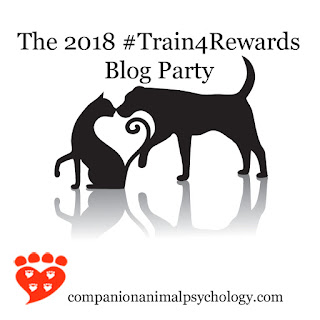 |
| Photo: Alzbeta / Shutterstock |
Whether you want to use counter-conditioning to get your dog to like other dogs, or desensitization to teach your dog that alone-time is okay, this guide is for you. It explains what these technical terms mean – and, importantly, the tips you need to know to get it right.
First, we’ll look at how to spot a fearful dog, because these techniques are often used to help resolve different kinds of fear.
Sometimes, desensitization and/or counter-conditioning are used alongside medication. If you are concerned about your pet or want to know if medication might help your dog, speak to your veterinarian.
Recognizing signs of fear in dogs
It can be difficult to recognize signs of fear in dogs, and people often miss it, even in situations where we know many dogs are afraid (e.g. fear at the vet or in response to loud noises).
This means many dogs are not being helped with their fears because their owner does not realize their dog is afraid. Another issue is that when dogs are afraid of fireworks, people may do their best to help their dog cope at the time – and then forget about the problem until a night like Halloween or 4th of July is coming up again.
When is the best time to start to help your dog get over their fear of fireworks? It’s actually right now, because this is something that takes time.
Some of the signs of fear to look for in your dog are a tucked tail, ears back, lip licking, looking away, lifting a paw, trembling or shaking, a lowered body posture, yawning, grooming, sniffing, seeking out people (e.g. looking for comfort from you), hiding, not moving, urinating and defecating.
For more information and some practice at spotting signs of stressed body language, see how can I tell if my dog is afraid?
Systematic desensitization
Desensitization means very gradual exposure to the scary thing, starting at a very low level and building up very slowly. It should be systematic, which means you have a plan to build up gradually. At every step on the way, you dog should be happy and comfortable.
If instead you notice your dog is even a tiny bit scared, you need to immediately go back to an easier stage of the plan. If you jump ahead too fast and frighten your dog, then you might be doing sensitization (making it worse) instead of desensitization!
As an example, suppose your dog is afraid of fireworks. You find a recording of firework sounds (such as the recordings from Dogs Trust that come with a booklet explaining what to do). You can’t start by playing the sounds at anywhere near normal volume, because you already know that frightens your dog. Instead, you start at a really low volume – maybe even barely audible.
Then gradually over time, always making sure your dog is comfortable, you keep turning up the volume a notch. Then another notch. And so on. Over time, assuming you get it right, your dog will learn to tolerate the sounds.
Counter-conditioning
Counter-conditioning is a type of classical conditioning. Have you heard about Ivan Pavlov and his dogs, how when he rang a bell the dogs salivated because they had learned it predicted they would be given food? Then you’ve heard of classical conditioning!
Classical conditioning involves automatic responses, like salivation, changes in heart rate, or nausea. These are involuntary reactions (not behaviours).
Most classical conditioning uses a neutral stimulus (like the sound of a bell). In counter-conditioning, we are trying to teach the dog to like something they already don’t like or are afraid of.
For example, suppose you have a dog that is afraid of other dogs, and you want to teach her to like them. In counter-conditioning, every time another dog appears, you would give your dog some very delicious food. Over time, she will learn that other dogs predict yummy food, and so she will learn to like other dogs.
Did you notice I said every time another dog appears? That’s because we want to have what’s known as a 1:1 ratio. If instead, sometimes when another dog appears your dog gets food, but sometimes when another dog appears they don’t, this won’t work very well.
Therefore, if you’re counter-conditioning something you might run into outside training sessions (like other dogs), you need to have a plan to either manage it (so it doesn’t happen) or to always have treats on you so you can still do counter-conditioning on those occasions too.
Open bar/closed bar
Jean Donaldson’s open bar/closed bar technique is a great way to do counter-conditioning. What it means is that when the scary thing appears (e.g. the other dog, or the sounds, etc…) the bar is open: treats will keep on flowing. Yay! It’s like a party! (Hopefully that’s what your dog will think).
Then when the scary thing stops (e.g. the other dog goes away, the sound stops, etc.) the bar is closed and the flow of treats stops. Now, nothing happens – the party is over.
A positive conditioned emotional response
Learning to recognize a positive conditioned emotional response is an essential part of doing desensitization and counter-conditioning, because you can’t move on to the next step until you’ve got a +CER.
Look for signs that the dog is happy and expecting food, such as a wagging tail and a happy, open mouth.
Desensitization and counter-conditioning
Desensitization and counter-conditioning are often used together. Trainers often abbreviate it to dscc.
If we stick to the example of a dog who is afraid of other dogs, we can use desensitization by keeping a suitable distance from the other dog. We should also take account of other aspects of the experience (for example, a moving dog might be more scary to your dog than one that is still, so a moving dog would need to be further away).
At the same time, we can use counter-conditioning by feeding delicious food as soon as your dog notices the other dog. Using these two techniques together works really well.
Desensitization and counter-conditioning is a good alternative to negative reinforcement because it does not involve aversive experiences for the dog.
There are some cases where we might use desensitization on its own. An example is to help a dog with separation anxiety get used to being left alone for gradually-increasing periods of time. The good news is that new technology can help in separation anxiety cases, because it enables you to see video of your dog at home to check she really is okay.
If your dog has separation anxiety, as well as speaking to your veterinarian, I recommend trainers with a certification called CSAT (Certified Separation Anxiety Trainer). They are specialists in resolving this problem, and many offer distance consults.
And at times when desensitization is not possible (or, due to a mishap, went wrong), you can still use counter-conditioning on its own.
Some common mistakes
There are some common mistakes that people make with desensitization and counter-conditioning. If you’re thinking, “I tried it and it didn’t work,” see if any of these might apply.
Not using good enough food
A common mistake is to not use good enough food. For counter-conditioning, I recommend using good food like chicken, cheese, or roast beef. For more ideas, see the best dog training treats.
Getting the timing mixed up
Your aim in counter-conditioning is to teach your dog that the scary thing predicts good stuff like great food. Have you ever had the experience of doing counter-conditioning, and then finding that when you offer your dog food, she starts looking round to see where the scary thing is? That means the timing was wrong and the dog now thinks food predicts something scary!
The thing to look for is when your dog notices the other dog (or whatever the scary thing is), and feed then. You have to pay attention to your dog in order to get this right.
Going too fast
This is probably the most common mistake of all: starting at too hard a level and going too fast for your dog.
Learning how to do desensitization and counter-conditioning will teach you to slow down, because you have to go at the dog’s pace. This will vary from dog to dog, but it will usually be very slow at the start. Then hopefully it will speed up along the way. But this dog training technique is not for the impatient!
Signs you are going too fast include the dog having a harder mouth when taking treats or only sometimes being interested in treats. Also watch out for any signs of worried body language such as a low tail or low posture. If you see any of these, go back to an easier step in the plan.
Not reading the dog’s body language
Learning how to read a dog’s body language is a skill that times time to acquire. To use desensitization and counter-conditioning, you need to be able to recognize when a dog is afraid (so you know these techniques are relevant, and so you notice if you accidentally go too fast). If the dog is afraid, you risk making things much worse instead of better.
You also need to be able to recognize when you have got a positive conditioned emotional response – a happy reaction to the previously-scary thing. It’s only when you see this that you can move to the next step in your plan.
Using a clicker
When we use a clicker in dog training, it’s to mark a behaviour that will be rewarded. In counter-conditioning, we are not teaching a behaviour; instead, we are trying to change the dog’s emotions. So there is no behaviour to click.
Even if you love using a clicker when doing operant conditioning (teaching a behaviour), put it away when doing counter-conditioning.
But I only want to feed the dog for being good
Sometimes people only want to feed the dog for being good. But the thing is, counter-conditioning isn’t about behaviour; it’s about changing the dog’s underlying feelings. So it does not matter what your dog is doing.
Sometimes we make a mistake and get too close to the scary thing. We’ve all done it! For example if you get too close to another dog and your dog lunges and growls at it. Sometimes people compound this mistake by telling the dog off for lunging and growling, but this won’t help and might make things worse.
Instead, you should get your dog further away from the other dog and then offer the yummy food anyway. The reason is that in counter-conditioning they should get the food every single time they see the scary thing. If they don’t, it’s basically an extinction trial that is starting to undo your training.
This can be quite difficult to do in public with other people looking on. But you shouldn’t feel embarrassed for doing the right thing for your dog.
So if your dog goes over threshold, get away as fast as you can and then feed them anyway. Of course, you might also like to say sorry to the owner of the dog yours just growled at as you move away, but you don’t have to get into a discussion.
The other thing you need to do is make a mental note that next time, you need more distance. Think about whether there were other things going on that might have made it more difficult for your dog – this is known as trigger stacking. And then plan to do better next time.
Remember, you’re trying to teach your dog – but it’s also a learning experience for you.
What about a DRI instead?
Sometimes dog trainers will choose a DRI (differential reinforcement of an incompatible behaviour) instead of counter-conditioning, with the aim of getting a classical conditioning side-effect. You can read more about this, and about the factors that will help you decide which to do, in my post on negative reinforcement. (Look for the section on alternatives to negative reinforcement).
A word on punishment
If you have a dog that is fearful or afraid, it’s important that you stop using punishment on your dog. Punishment is stressful and there is a risk it will make your dog’s fear worse, or even make your dog afraid of you. Punishment may suppress behaviour, but it does not teach your dog what you would like them to do instead. For more information, see my post on positive punishment in dog training.
If you are using any kind of punishment (including prong and shock collars), stop. This is an important part of helping a fearful dog.
Summary
Desensitization and counter-conditioning are powerful techniques that we can use to help dogs learn to like something they are afraid of. They can be used in many dog training situations, from fear of loud noises to fear of being left alone, fear of implements like nail clippers and stethoscopes, and fear of strangers.
These techniques are more advanced than obedience training, and it will take practice (and a good plan) to learn to get them right. Hopefully this article has helped explain the basics. You can also check out eight tips to help fearful dogs feel safe.
If you need help with your dog’s issues, see my article on how to choose a dog trainer.
Subscribe to Companion Animal Psychology to learn more about how to have happy dogs and cats.
Further Reading
Interview with Jean Donaldson about The Culture Clash
Dogs Are from Neptune
The Trainable Cat: A Practical Guide to Making Life Happier for You and Your Cat
From Fearful to Fear Free: A Positive Program to Free Your Dog from Anxiety, Fears, and Phobias
Excel-erated Learning: Explaining in plain English how dogs learn and how best to teach them
Companion Animal Psychology is a participant in the Amazon Services LLC Associates Program, an affiliate advertising program designed to provide a means for sites to earn advertising fees by advertising and linking to Amazon.com and affiliated sites. Companion Animal Psychology is also a participant in the Etsy Affiliate Program, an affiliate advertising program designed to provide a means for sites to earn advertising fees by advertising and linking to Etsy.com.




























